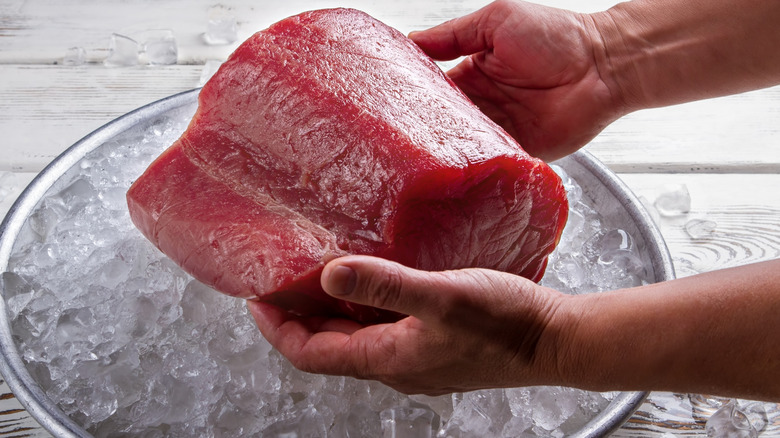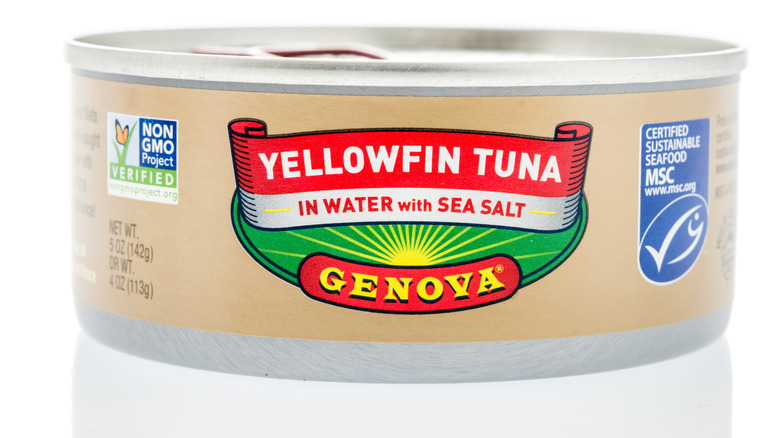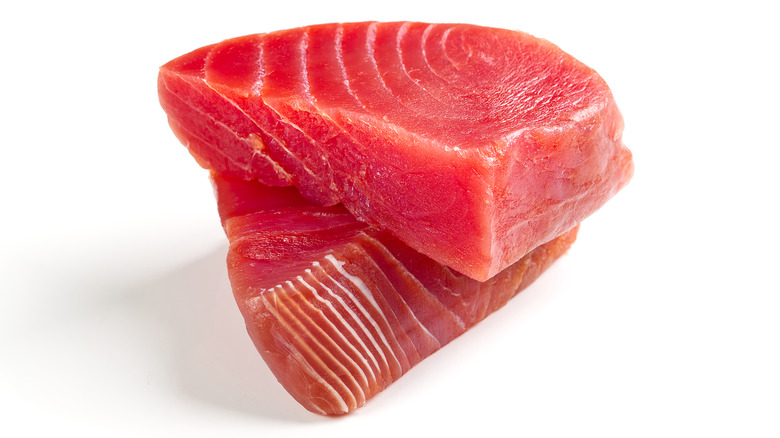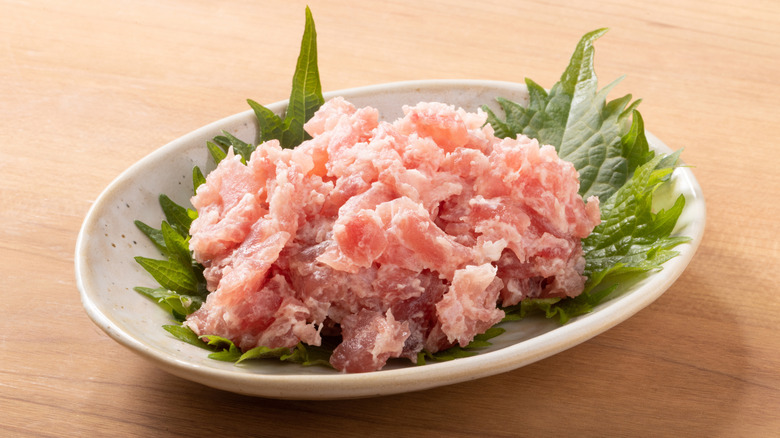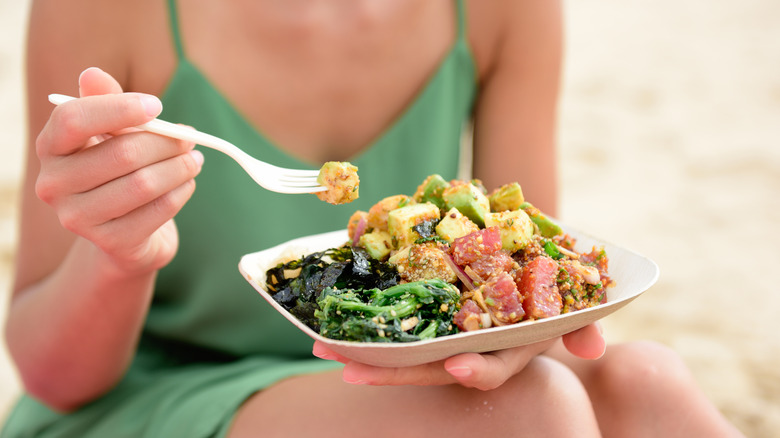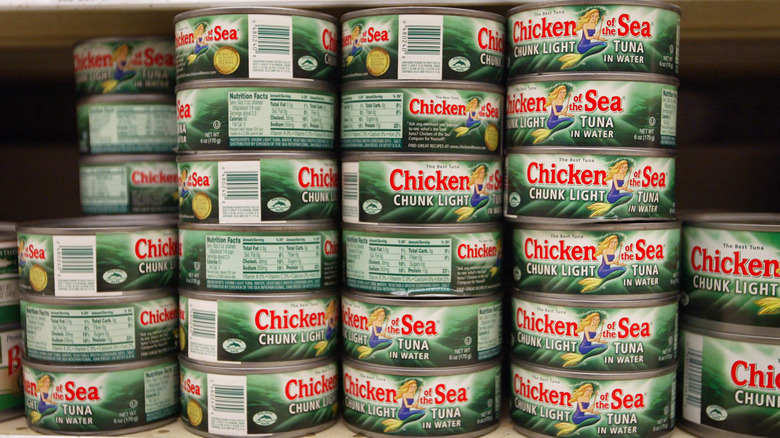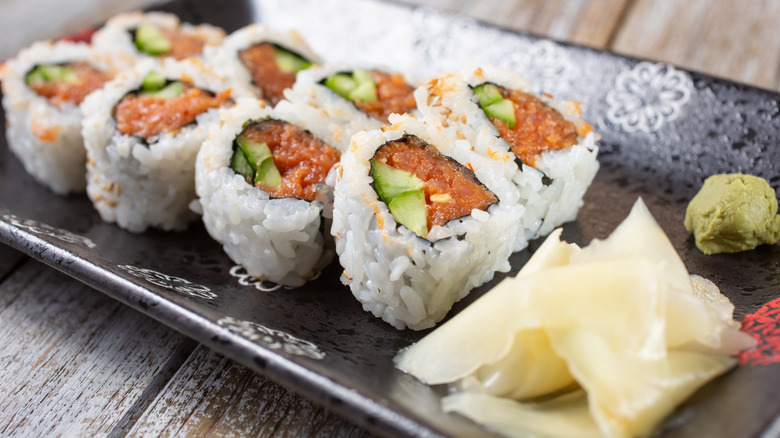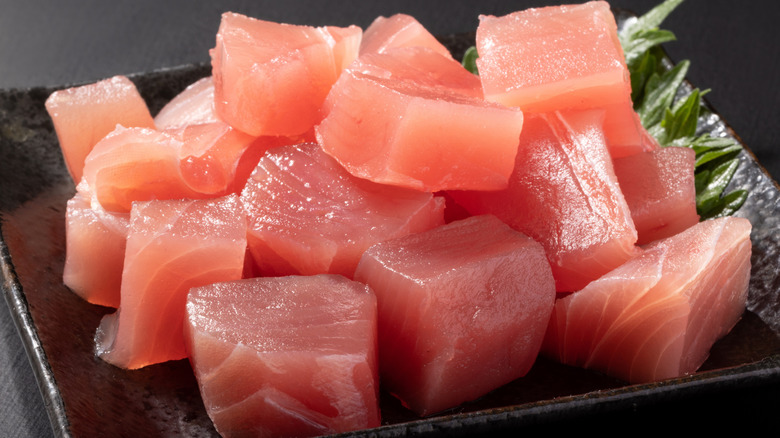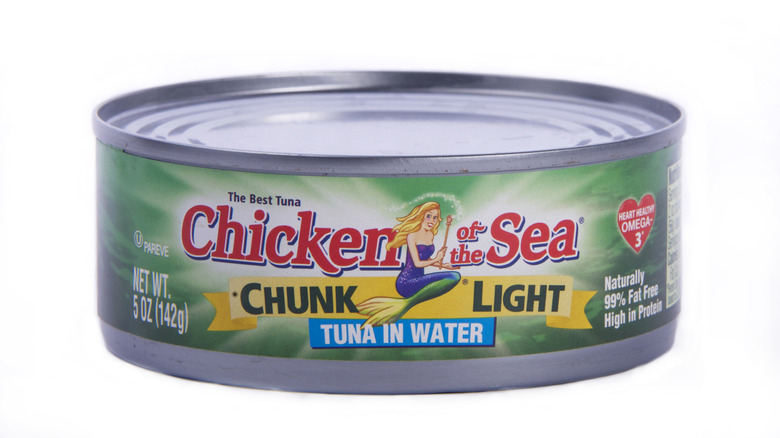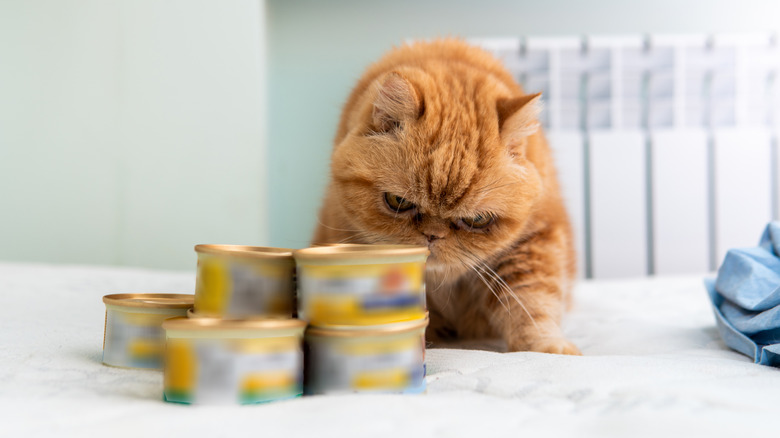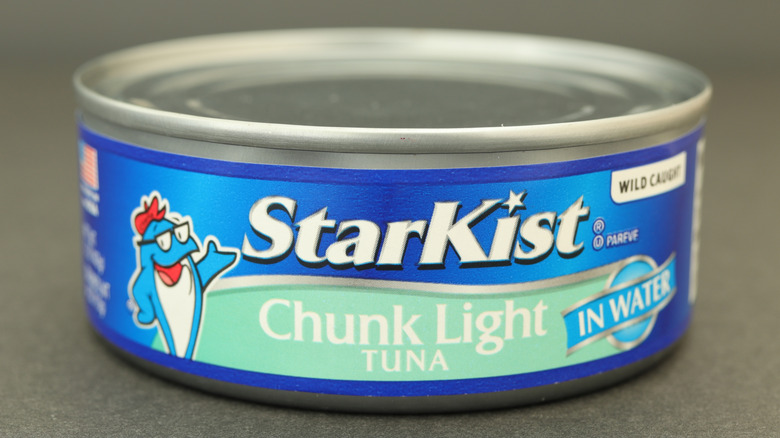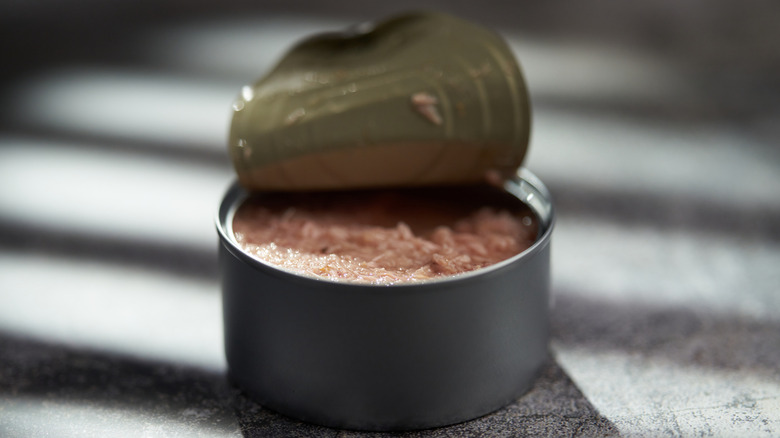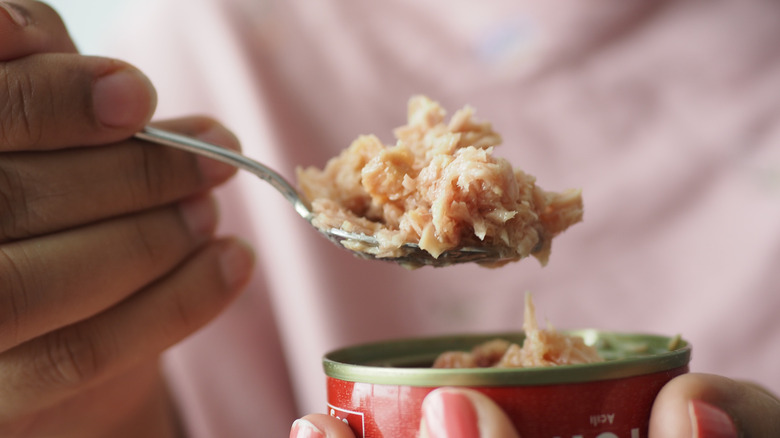The 14 Worst Canned Tuna Recalls
If there's one seafood the world just can't get enough of, it's tuna. In 2022, this pantry staple ranked third in the National Fisheries Institute's list of the most consumed seafoods, with a per capita consumption of a staggering 2.2 pounds. Tuna's popularity is behind a sprawling multi-billion dollar industry, spanning multiple continents and countless supply chains. But with such scale comes tremendous risk.
The sheer size of the industry, combined with strict regulatory oversight and tuna's natural susceptibility to contamination, makes the odds of something going wrong extremely high. Even minor slip-ups, like storing it a little too warm for a little too long, can spiral into massive recalls, multi-state disease outbreaks, and even full-on public health situations. So, before you crack open that can of chunk light in water, take a moment to appreciate some of the worst — and weirdest — ways your favorite tuna brands have ended up on the recall list.
Tri-Union Seafoods (2025)
Going the grocery store route with your seafood can be hit or miss. You might spend all day checking for freshness and nitpicking the label, but ultimately, you may not know something is wrong with your grocery store tuna until it starts making headlines left and right. You might be thinking: What are the odds of that actually happening? Well, not as low as you'd want.
In February 2025, canned tuna sold by multiple retailers — including Trader Joe's, Costco, Safeway, Walmart, and Publix — made headlines following a massive recall involving multiple brands, including Genova, H-E-B, Trader Joe's, and Van Camp's. The issue? The manufacturer, Tri-Union Seafoods, discovered the products' seal integrity had been compromised due to a defect in the pull tab lid.
Seal integrity is one of the many things you really can't mess with when it comes to canning, especially with seafood like tuna, which is highly susceptible to contamination when improperly canned. And this isn't just the kind of contamination that leaves you chained to your bathroom floor for a couple of days. Worse things can happen. You could get botulism — a rare form of food poisoning that can land you in the hospital for weeks, or worse.
Northern Fisheries (2019)
With tuna being consumed on such a grand scale around the world, it should come as no surprise that its supply chain is wildly convoluted. Those bits of tuna in your upscale tuna casserole could've been caught off the coast of West Africa, shipped to a processing plant in Vietnam, packaged and frozen in Canada all before landing in your local grocery store freezer aisle. And if something about that wonky supply chain doesn't quite sit right with you, then you may be on to something. Each step in the chain introduces a whole new set of variables, which makes the likelihood of mishaps extremely likely.
That's exactly what Rhode Island–based seafood giant Northern Fisheries found itself contending with in 2019 after an unspecified amount of its frozen wild-caught yellowfin tuna medallions — imported from Vietnam and under the brand name Tuna King — was found to be tainted with histamine. Histamine can accumulate pretty rapidly in tuna, especially if it's stored at high temperatures or mishandled during harvesting or transport. And if you're importing your tuna from tropical regions like Vietnam, temperature abuse is almost unavoidable. The good news is that no one reported coming down with scombroid fish poisoning — a likely consequence of eating fish tainted with histamine — and the bad batches were successfully removed from circulation.
Jensen Tuna (2019)
Histamine build-up isn't the only thing that can go wrong in tuna's mind-warping supply chain. After all, the godfather of food contamination, Salmonella, doesn't take time off — and can rear its ugly head at any step in the chain. Whether it's right at the start — fish being harvested from water tainted with human and/or animal waste (yep, gross) — or at the tail end, when someone's assembling your poke bowl at your go-to sushi spot with questionable hygiene, there's no shortage of ways Salmonella can sneak into your tuna.
One company that might have some firsthand experience with this is Jensen Tuna. In 2019, the Louisiana-based seafood supplier recalled a massive amount of its frozen ground tuna from restaurants and wholesalers after it was linked to an outbreak of Salmonella Newport that sickened at least 15 people across eight states. Those affected reported eating seafood made with raw fish about a week before experiencing the tell-tale symptoms of Salmonella poisoning. While the exact point of contamination is anyone's guess, every establishment tied to the outbreak had just one supplier in common: Jensen Tuna.
Tropic Fish Hawaii LLC (2017)
If you're a lover of raw seafood, then you understand you can't get that stuff from anywhere. Location matters — well, that is if you're trying to avoid wrecking your guts with a bad case of food poisoning. But even the most finicky sushi connoisseur probably believes that Hawaii is a pretty safe bet when it comes to sourcing raw seafood. That assumption, as it turns out, couldn't be further from the truth. Despite being located smack in the middle of the Pacific and having its very own tuna auction, this tropical paradise is by no means immune to the dangers of tuna's wacky supply chain.
In 2017, Tropic Fish Hawaii LLC, one of the major seafood distributors in the state, was forced to pull an unspecified amount of its imported frozen ahi cubes from establishments across the state — including Times Supermarket, Da CrabShack Kapolei, and Shima's — after it was found to be tainted with Hepatitis A; a dangerous food contaminant that can cause illness ranging from mild stomach upset to full-blown liver damage. Following the recall, the FDA slapped an import alert on P.T. Deho Canning Company, the Indonesian company that had initially supplied the frozen ahi cubes to Tropic Fish.
Tri-Union Seafoods (2016)
Let's face it — the risks notwithstanding, there's something about raw tuna that keeps you coming back. But even then, you want to know that you're playing raw fish roulette and prepare yourself accordingly. You also want to be sure that certain steps, like freezing at very low temperatures, have been taken to mitigate risks. It's an entirely different story when you eat par-raw seafood without actually knowing about it. Then, coming down with a terrible case of Salmonella or Norovirus seems less earned, and more like a complete rip-off.
That's exactly the kind of grievance customers of California-based tuna giant Tri-Union Seafoods might've had after the company recalled a whopping 107,280 cans of its Chicken of the Sea brand chunk light tuna in water and oil due to potential undercooking. The mishap was traced back to an equipment malfunction that compromised the sterilization process about a month after the products made their way to retailers nationwide.
John DeBeer, vice president of Quality and Compliance for Chicken of the Sea, said the company issued a recall because of a machine malfunction — and they replaced the faulty part.
Osamu Corporation (2015)
In the order of suspiciousness, grocery store sushi probably ranks somewhere between gas station rolls and that too-good-to-be-true restaurant sushi special you ordered once and have since steered clear of. And if you know what kind of red flags to watch out for, like a poke bowl that's way past its sell-by date or a spicy tuna roll that doesn't quite pass the sniff test, grocery store sushi is not necessarily a bad idea.
One thing to remember: When sushi is a bad idea, it's a really bad idea. Just ask California-based seafood distributor Osamu Corporation, who in 2015 was forced to recall massive amounts of its imported frozen yellowfin tuna, including loin, slice, and saku, after it was linked to outbreaks of Salmonella paratyphi and Salmonella Weltevreden that swept across 11 states and sickened a startling 65 people. The tainted tuna was sold in bulk to retail establishments across the country, including grocery stores, and subsequently used to prepare sushi. Of the 65 people who fell ill after eating the tainted fish, 11 were hospitalized — but thankfully, none of the cases proved fatal.
Moon Marine USA (2012)
Tuna might be a kitchen staple in many American households, but that doesn't mean the tuna itself is American. About 90% of the tuna you'll find in your local grocery store in the country is imported, and with the FDA being so undermanned and under-resourced, only a roughly 2% of imported seafood actually undergoes physical inspection. This means we've got tons of mystery tuna getting into the country, a lot of it from countries where the oversight in regulatory oversight is more of suggestion than strict protocol.
So, while certainly disconcerting, it wasn't much of a shocker when, in 2012, imported fish landed California-based seafood distributor Moon Marine USA's frozen raw Nakaochi Scrape on the wrong side of the FDA. Sourced from India's Moon Fishery Pvt. Ltd., the tainted tuna was linked to outbreaks of Salmonella Bareilly and Salmonella Nchanga that sickened 425 people from 28 states and the District of Columbia. Though no deaths were reported, 55 of those infected had such severe symptoms that they ended up hospitalized. As a result, the company issued a recall for 58,828 pounds of the tainted yellowfin tuna. In addition, the FDA placed Moon Fishery Pvt. Ltd. on its red list, effectively banning the company from exporting any of its tuna to the United States.
Osamu Corporation (2011)
While it might get you some curious looks, a precautionary sniff test is always a great idea when buying your sushi from the grocery store. You might not be able to catch a whiff of Salmonella no matter how long you keep your nose in there, but you could save yourself from buying sushi rolls made with decomposing tuna.
And if you need concrete proof, look no further than Osamu Corporation, a seafood distributor that primarily sells in bulk to grocery stores and restaurants. In 2011, routine FDA testing revealed decomposition and elevated histamine levels in multiple batches of the company's frozen ground tuna. As a result, the company was forced to pull a staggering 1,800 cases of its ground tuna from circulation.
The sad news was that among its clientele were AFC Corporation and Red Shell Foods, two of the biggest grocery store sushi franchisers in the country. So, by the time the recall was issued, three people had already come down with scombroid fish poisoning after eating tainted grocery store sushi.
Tri-Union Seafoods (2010)
There are a few things you want from your tuna can. For instance, 5-ounce tuna cans should actually contain 5 ounces of tuna. What you don't want? Canned tuna that leaves your grocery bag smelling like it's been dragged through the Honolulu Fish Auction and you're fighting off an aggressive case of botulism — all because someone at the cannery forgot to seal it properly. But that's exactly what shoppers were risking when they bought Chicken of the Sea brand 12-ounce solid white tuna in water in 2010.
Tri-Union Seafoods, the company behind the brand, discovered the issue after routine testing revealed that a batch of products distributed between February and May of that year had loose seals. The discovery resulted in 1,105 cases of the compromised products, which had already been distributed to 10 states, being removed from the market. Shue Wing Chan, Tri-Union Seafood's president and CEO, said they took quick action to instigate a recall and notify customers and authorities.
Ocean King Foods (1992)
Mislabelling imported fish as locally sourced or embellishing sustainability reports — these are just a few of the many ways seafood companies have tried to pull a fast one on consumers. But these might seem almost quaint stacked up against the kind of stunt Ocean King Foods pulled in 1992.
The whole thing kicked off in July 1992 after multiple consumers in Minnesota reported purchasing cans of 6.5-ounce IGA Chunk Tuna in Water, only to discover that it had been initially been labeled as cat food. One unhappy customer said she threw up when she found a label underneath the public label on the can.
FDA investigators quickly got involved, subsequently uncovering and seizing 38,640 cans of the feline-turned-human food tucked away in a warehouse in Teterboro, New Jersey. Further traceback revealed the batch to be part of a much larger stockpile — between 25 and 50 million pounds — of decomposing tuna originally recalled by Starkist Canada in 1985 following the infamous Tunagate scandal. Rather than being disposed of, the recalled tuna crossed the border into the United States where it was relabeled as Seventh Heaven cat food.
Starkist Canada (1985)
Long before Clover Leaf Seafoods and Bumble Bee Foods took over, Starkist Canada was by far the biggest player in the Canadian canned tuna market. Things took an unfortunate turn in 1985 when the company got wrapped up in what is arguably the biggest tuna scandal in history.
Things started going south after testing by inspectors from the Department of Fisheries and Oceans revealed decomposition in more than 1 million cans of tuna at the company's New Brunswick processing plant. Losing such a massive shipment of tuna spelled disaster for Starkist, and would've meant permanent closure of its St. Andrews processing plant — a predicament that somehow roused the sympathies of then New Brunswick Prime Minister, Richard Hatfield.
Hankering for a workaround, Starkist and Hatfield approached then Canadian minister of Fisheries and Oceans, John Fraser, who ordered a separate round of testing that surprisingly found the tuna fit for human consumption. Spoiler: it wasn't. The rancid odor and poor appearance of the tuna did not go unnoticed by consumers, and soon thereafter, Starkist and Fraser found themselves knee-deep in the mire of a full-blown tuna scandal. The tuna was recalled, the St. Andrews plant shut down, and Fraser was ultimately forced to resign from office.
Bumble Bee Foods (1982)
Taking the cake for the biggest tuna recall in history, at least by sheer volume, is Bumble Bee Foods. In 1982, the San Diego-based seafood giant found itself pulling a startling 40 million cans of tuna from retailers across the country after they were found to have defective packaging. An FDA investigation, triggered by consumer reports of purchasing spoiled tuna, found holes in multiple cans produced at the company's Honolulu processing plant. Although no toxins were found in the compromised cans, additional consumer complaints later emerged, forcing the FDA to issue a recall.
Affecting the entire lot of canned tuna produced at Bumble Bee's Honolulu plant in 1981 and almost half of 1982, the recall was so massive, it had some industry experts worried about a temporary canned tuna shortage. Julie Rose, then chairman of Sloan's supermarket chain, explained that the impact would hit all tuna fish and that it would take several months to come back.
Grand Union (1970)
If you're looking for fish that's low in mercury, then tuna really isn't for you. Tuna live off other smaller fish, which means they'll likely contain a lot more mercury than, say, sardines. While a lot of the tuna you'll find anywhere is quite high in mercury, that doesn't mean the FDA won't intervene when you're taking in a lot more mercury than you should. One of the earliest testaments to this was in 1970 when at least 1 million pounds of canned tuna were removed from circulation after the agency found them to contain mercury levels surpassing acceptable thresholds.
At the centerfold of the recall was Grand Union, the Vermont-based company behind the Grand Union supermarket chain. Then moonlighting as a seafood distributor, the company was forced to pull an unspecified amount of its canned tuna from stores after preliminary FDA testing revealed excessive mercury levels. The recall spurred a broader investigation into mercury levels in canned tuna, resulting in a wider recall spanning multiple popular brands.
Washington Packing Corporation (1963)
In March 1963, two botulism-related deaths were reported in Wayne County, Michigan. Margaret McCarthy, 39, and Collette Brown, 37, reportedly passed away within hours of each other after consuming canned tuna purchased from an A&P store in the area.
The FDA and CDC concluded that, while the tuna was heated properly during processing, the problem was in defective sealing. George T. Daughters, then Detroit FDA chief, explained that it was likely a case of botulism. The outbreak was significant in that it proved botulism could impact commercially prepared food and that improper lids or closures can be a big factor.
Following the incident, A&P disposed off what remained of its original consignment of 120 cases, which was part of a larger shipment of 26,400 cans imported from Japan and supplied by San Francisco's Washington Packing Corporation.

